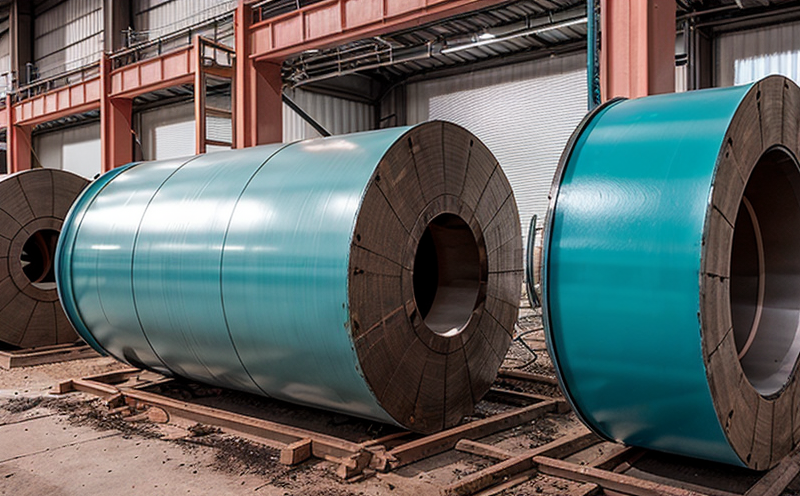ASTM G85 Acidified Salt Fog Corrosion Testing
The ASTM G85 Acidified Salt Fog (ASF) corrosion testing method is a crucial procedure used to evaluate the resistance of materials and coatings against corrosive environments. This test simulates atmospheric exposure conditions that are particularly harsh, thereby providing valuable data on the durability and longevity of products in industrial settings.
Corrosion, especially salt fog corrosion, is one of the most common forms of material degradation encountered in industrial manufacturing and processing facilities. Salt fog can cause significant damage to unprotected metals, leading to premature failures in equipment, structures, and components. ASTM G85 specifically focuses on accelerated testing by subjecting specimens to a corrosive environment that mimics conditions found in coastal areas or environments with high humidity.
The test involves exposing the specimen to an acidic salt solution in a fog chamber at specific temperature and relative humidity levels. The duration of exposure can vary depending on the desired outcome, but it typically ranges from 168 hours (7 days) up to several weeks. During this period, the specimen is continuously exposed to the corrosive environment. After the prescribed time has elapsed, the specimens are inspected for signs of corrosion such as pitting, rusting, or loss of weight.
ASTM G85 is widely recognized and used in various industries including automotive, aerospace, electronics, and construction. It provides a standardized method to compare different materials' resistance to corrosive environments. This ensures that manufacturers can make informed decisions regarding material selection, coating application, and quality assurance processes. By using ASTM G85, companies can ensure compliance with international standards while also improving product performance and reliability.
The test procedure is meticulously defined in the ASTM G85 standard, which includes detailed instructions on specimen preparation, chamber setup, exposure duration, and evaluation criteria. Compliance with these guidelines ensures consistent and reliable results across different laboratories and testing facilities.
Testing under ASTM G85 conditions provides insights into how well materials will perform in real-world environments where salt fog is present. This information can be used to optimize product design, improve manufacturing processes, and enhance overall quality control measures. Additionally, the test helps identify potential weaknesses in material selection or coating application early on in the development cycle.
Understanding the parameters involved in ASTM G85 testing is essential for those responsible for ensuring product integrity across various industries. By familiarizing themselves with these aspects, stakeholders can better appreciate the importance of this testing method and its role in maintaining high standards within their organizations.
Industry Applications
The ASTM G85 Acidified Salt Fog Corrosion Testing is applicable across numerous sectors where materials must withstand corrosive environments. Here are some key industries that benefit from this testing:
- Automotive Industry: Ensuring the longevity of exterior components, such as body panels and exhaust systems.
- Aerospace Sector: Evaluating the durability of aircraft parts exposed to extreme environmental conditions during flights.
- Electronics Manufacturing: Assessing the robustness of electronic enclosures against corrosion caused by moisture and salt deposits.
- Construction Industry: Determining the resistance of building materials used in coastal or humid regions.
In each of these sectors, ASTM G85 plays a vital role by providing consistent and reliable data on material performance under simulated corrosive conditions. This ensures that products meet regulatory requirements and customer expectations while also enhancing their overall durability.
Eurolab Advantages
At Eurolab, we pride ourselves on offering comprehensive ASTM G85 Acidified Salt Fog Corrosion Testing services tailored to meet the needs of our clients in various industries. Our state-of-the-art facilities and experienced team provide unparalleled accuracy and precision in conducting these tests.
- Comprehensive Test Capabilities: We offer full-service testing solutions encompassing all aspects of ASTM G85, including specimen preparation, chamber operation, and post-test analysis.
- Expertise and Experience: Our team consists of highly qualified professionals with extensive experience in performing ASTM G85 tests. They understand the nuances involved in achieving consistent results.
- Standardized Procedures: Eurolab adheres strictly to ASTM standards, ensuring that every test conducted meets the highest industry benchmarks.
- Rapid Turnaround Times: Clients can expect fast turnaround times without compromising on quality or accuracy.
We understand that time is critical in many business operations. Therefore, our goal is to deliver accurate results promptly so that you can make informed decisions based on reliable data.
Environmental and Sustainability Contributions
The ASTM G85 Acidified Salt Fog Corrosion Testing has significant implications for environmental sustainability by helping manufacturers design more durable products. By identifying materials and coatings capable of withstanding corrosive environments, industries can reduce waste and extend product lifecycles.
Incorporating sustainable practices into manufacturing processes not only benefits the environment but also improves operational efficiency and reduces costs associated with frequent replacement or repair of corroded components. For instance, in the automotive industry, durable coatings on exterior parts could lead to longer vehicle life spans, reducing the number of replacements needed over time.
Moreover, by selecting materials that are resistant to corrosive environments, manufacturers can contribute positively towards minimizing resource depletion and waste generation. This aligns closely with broader sustainability goals aimed at promoting circular economies where products have extended lifecycles before being recycled or repurposed.
The ASTM G85 test serves as an essential tool in achieving these objectives by providing valuable insights into material performance under challenging conditions. Through this testing, industries can innovate and develop solutions that enhance both product longevity and environmental responsibility.





